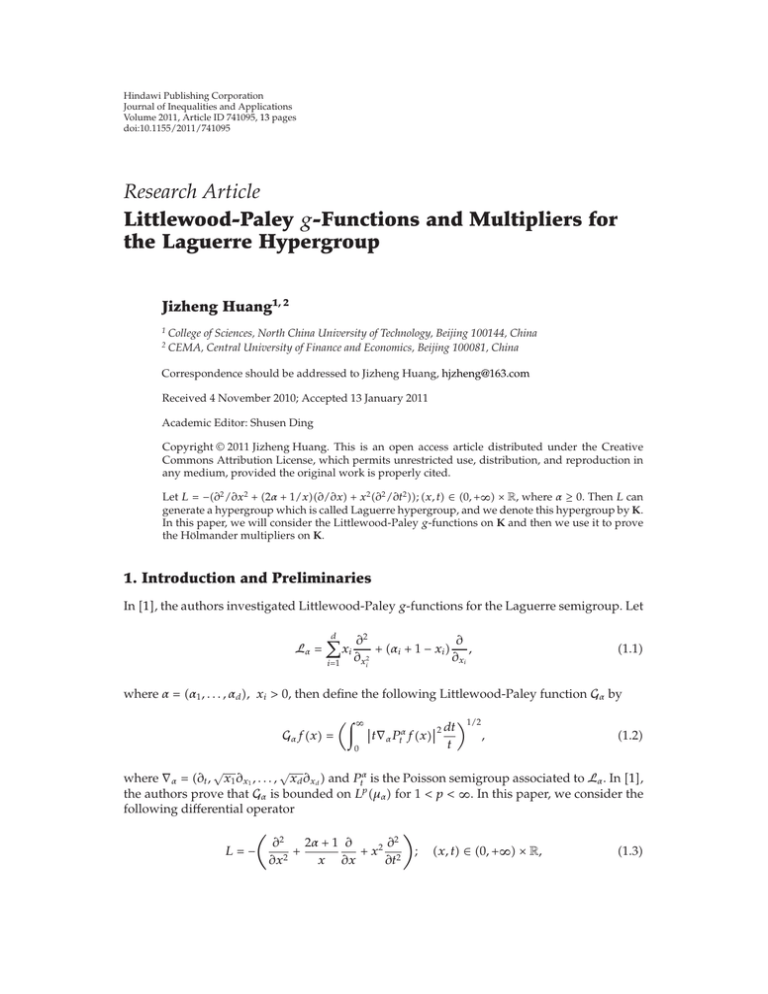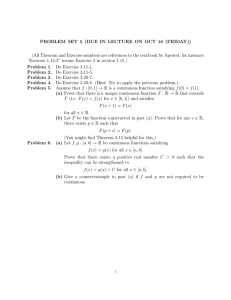Document 10943875
advertisement

Hindawi Publishing Corporation
Journal of Inequalities and Applications
Volume 2011, Article ID 741095, 13 pages
doi:10.1155/2011/741095
Research Article
Littlewood-Paley g-Functions and Multipliers for
the Laguerre Hypergroup
Jizheng Huang1, 2
1
2
College of Sciences, North China University of Technology, Beijing 100144, China
CEMA, Central University of Finance and Economics, Beijing 100081, China
Correspondence should be addressed to Jizheng Huang, hjzheng@163.com
Received 4 November 2010; Accepted 13 January 2011
Academic Editor: Shusen Ding
Copyright q 2011 Jizheng Huang. This is an open access article distributed under the Creative
Commons Attribution License, which permits unrestricted use, distribution, and reproduction in
any medium, provided the original work is properly cited.
Let L −∂2 /∂x2 2α 1/x∂/∂x x2 ∂2 /∂t2 ; x, t ∈ 0, ∞ × R, where α ≥ 0. Then L can
generate a hypergroup which is called Laguerre hypergroup, and we denote this hypergroup by K.
In this paper, we will consider the Littlewood-Paley g-functions on K and then we use it to prove
the Hölmander multipliers on K.
1. Introduction and Preliminaries
In 1, the authors investigated Littlewood-Paley g-functions for the Laguerre semigroup. Let
Lα d
∂
∂2
xi
αi 1 − xi ,
2
∂
∂
xi
xi
i1
1.1
where α α1 , . . . , αd , xi > 0, then define the following Littlewood-Paley function Gα by
Gα fx ∞
0
t∇α P α fx2 dt
t
t
1/2
,
1.2
√
√
where ∇α ∂t , x1 ∂x1 , . . . , xd ∂xd and Ptα is the Poisson semigroup associated to Lα . In 1,
the authors prove that Gα is bounded on Lp μα for 1 < p < ∞. In this paper, we consider the
following differential operator
L−
2
2α 1 ∂
∂2
2 ∂
x
x ∂x
∂x2
∂t2
;
x, t ∈ 0, ∞ × R,
1.3
2
Journal of Inequalities and Applications
where α ≥ 0. It is well known that it can generate a hypergroup cf. 2, 3 or 4. We will
define Littlewood-Paley g-functions associated to L and prove that they are bounded on
Lp K for 1 < p < ∞. As an application, we use it to prove the Hömander multiplier theorem
on K.
Let K 0, ∞ × R equipped with the measure
1
x2α1 dxdt,
πΓα 1
dmα x, t α ≥ 0.
1.4
p
We denotes by Lα K the spaces of measurable functions on K such that fα,p < ∞, where
fα,p K
fx, tp dmα x, t
fα,∞ esssupx,t∈K
1/p
,
1 ≤ p < ∞,
fx, t.
1.5
α
For x, t ∈ K, the generalized translation operators Tx,t are defined by
α Tx,t f y, s
⎧ 2π 1
⎪
⎪
⎪
f
x2 y2 2xy cos θ, s t xy sin θ dθ,
if α 0,
⎪
⎪
⎨ 2π 0
⎪
α−1
⎪
α 2π 1 2
⎪
⎪
x y2 2xyr cos θ, s t xyr sin θ r 1 − r 2
drdθ, if α > 0.
⎪
⎩ π 0 0f
1.6
α
It is known that Tx,t satisfies
α
Tx,t f
α,p
≤ fα,p .
1.7
Let Mb K denote the space of bounded Radon measures on K. The convolution on Mb K
is defined by
μ∗ν
f K×K
α Tx,t f y, s dμx, tdν y, s .
1.8
It is easy to see that μ ∗ ν ν ∗ μ. If f, g ∈ L1α K and μ fmα , ν gmα , then μ ∗ ν f ∗ gmα ,
where f ∗ g is the convolution of functions f and g defined by
f ∗ g x, t K
α Tx,t f y, s g y, −s dmα y, s .
The following lemma follows from 1.7.
1.9
Journal of Inequalities and Applications
3
p
Lemma 1.1. Let f ∈ L1α K and g ∈ Lα K, 1 ≤ p ≤ ∞. Then
f ∗ gα,p ≤ fα,1 gα,p .
1.10
K, ∗, i is a hypergroup in the sense of Jewett cf. 5, 6, where i denotes the involution
defined by ix, t x, −t. If α n − 1 is a nonnegative integer, then the Laguerre hypergroup
K can be identified with the hypergroup of radial functions on the Heisenberg group Hn .
The dilations on K are defined by
δr x, t rx, r 2 t ,
1.11
r > 0.
It is clear that the dilations are consistent with the structure of hypergroup. Let
fr x, t r −2α4 f
x t
, 2 .
r r
1.12
Then we have
fr α,1 fα,1 .
1.13
1/4
We also introduce a homogeneous norm defined by x, t x4 4t2 cf. 7. Then we
can defined the ball centered at 0, 0 of radius r, that is, the set Br {x, t ∈ K : x, t < r}.
Let f ∈ L1α K. Set x ρcos θ1/2 , t 1/2ρ2 sin θ. We get
K
fx, tdmα x, t 1
2πΓα 1
π/2 ∞ 1
f ρcos θ1/2 , ρ2 sin θ ρ2α3 cos θα dρdθ.
2
−π/2 0
1.14
If f is radial, that is, there ia a function ψ on 0, ∞ such that fx, t ψx, t, then
1
fx, tdmα x, t 2πΓα
1
K
π/2
−π/2
∞
α
cos θ dθ
Γα 1/2
√
2 π Γα 1Γα/2 1
ψ ρ ρ2α3 dρ
0
∞
ψ ρ ρ2α3 dρ.
1.15
0
Specifically,
Γα 1/2
r 2α4 .
mα Br √
4 πα 2Γα 1Γα/2 1
1.16
We consider the partial differential operator
L−
2
∂2
2α 1 ∂
2 ∂
x
x ∂x
∂x2
∂t2
.
1.17
4
Journal of Inequalities and Applications
L is positive and symmetric in L2α K, and is homogeneous of degree 2 with respect to the
dilations defined above. When α n − 1, L is the radial part of the sublaplacian on the
Heisenberg group Hn . We call L the generalized sublaplacian.
α
Let Lm be the Laguerre polynomial of degree m and order α defined in terms of the
generating function by
∞
1
α
sm Lm x m0
1 − sα1
xs
.
exp −
1−s
1.18
For λ, m ∈ R × N, we put
ϕλ,m x, t m! Γα 1 iλt −1/2|λ|x2 α e e
Lm |λ|x2 .
Γm α 1
1.19
The following proposition summarizes some basic properties of functions ϕλ,m .
Proposition 1.2. The function ϕλ,m satisfies that
a ϕλ,m α,∞ ϕλ,m 0, 0 1,
α
b ϕλ,m x, t ϕλ,m y, s Tx,t ϕλ,m y, s,
c Lϕλ,m |λ|4m 2α 2ϕλ,m .
Let f ∈ L1α K, the generalized Fourier transform of f is defined by
m fλ,
K
fx, tϕ−λ,m x, tdmα x, t.
1.20
It is easy to show that
m
f ∗ g λ, m fλ,
g λ, m,
fr λ, m f r 2 λ, m .
1.21
Let dγα be the positive measure defined on R × N by
R×N
gλ, mdγα λ, m ∞
Γm α 1
m0
m! Γα 1
R
gλ, m|λ|α1 dλ.
1.22
p
instead of Lp R × N, dγα . We have the following Plancherel formula:
Write Lα K
2 ,
fα,2 f
Lα K
f ∈ L1α K ∩ L2α K.
1.23
Journal of Inequalities and Applications
5
Then the generalized Fourier transform can be extended to the tempered distributions. We
also have the inverse formula of the generalized Fourier transform.
fx, t R×N
mϕλ,m x, tdγα λ, m
fλ,
1.24
provided f ∈ L1α K.
In the following, we give some basic notes about the heat and Poisson kernel whose
proofs can be found in 8. Let {H s } {e−sL } be the heat semigroup generated by L. There is
a unique smooth function hx, t, s hs x, t on K × 0, ∞ such that
H s fx, t f ∗ hs x, t.
1.25
We call hs is the heat kernel associated to L. We have
hs x, t R
λ
2 sinh2λs
hs x, t ≤ Cs
α1
e−1/2λ coth2λsx eiλt dλ,
2
−α−2 −A/sx,t2
e
1.26
.
√
Let {P s } {e−s L } be the Poisson semigroup. There is a unique smooth function px, t, s ps x, t on K × 0, ∞, which is called the Poisson kernel, such that
P s fx, t f ∗ ps x, t.
1.27
The Poisson kernel can be calculated by the subordination. In fact, we have
ps x, t
−2α5/4
∞ α1 2
4s
5
λ
√ Γ α
s2 x2 λ coth λ 2λt2
2
sinh λ
π
0
5
2λt
dλ,
× cos
α
arctan 2
2
s x2 λ coth λ
−α5/2
ps x, t ≤ C s s2 x, t2
.
1.28
The heat maximal function MH is defined by
MH fx, t supH s fx, t sup f ∗ hs x, t.
s>0
1.29
s>0
The Poisson maximal function MP is defined by
MP fx, t supP s fx, t sup f ∗ ps x, t.
s>0
s>0
1.30
6
Journal of Inequalities and Applications
The Hardy-Littlewood maximal function is defined by
1
MB fx, t sup
r>0 mα Br Br
α Tx,t f y, s dmα y, s sup f ∗ br x, t,
1.31
r>0
where bx, t 1/mα B1 χB1 x, t.
The following proposition is the main result of 8.
Proposition 1.3. MB MP and MB are operators on K of weak type 1, 1 and strong type p, p for
1 < p ≤ ∞.
The paper is organized as follows. In the second section, we prove that Littlewoodp
Paley g-functions are bounded operators on Lα K. As an application, we prove the
Hörmander multiplier theorem on K in the last section.
Throughout the paper, we will use C to denote the positive constant, which is not
necessarily same at each occurrence.
2. Littlewood-Paley g-Function on K
Let k ∈ N, then we define the following G-function and gλ∗ -function
2
gk f x, t gk∗
2
f x, t 0
∞ 0
∞ 2
k s
∂s P fx, t s2k−1 ds,
−α1
K
s
2
4 −k α
s
∂s P T
1 s y, r fx, t dmα y, r ds.
y,r 2.1
−2
Then, we can prove
Theorem 2.1. a For k ∈ N and f ∈ L2 K, there exists Ck > 0 such that
gk f α,2 Ck fα,2 .
2.2
b For 1 < p < ∞ and f ∈ Lp K, there exist positive constants C1 and C2 , such that
C1 fα,p ≤ gk f α,p ≤ C2 fα,p .
2.3
c If k > α 2/2 and f ∈ Lp K, p > 2, then there exists a constant C > 0 such that
gk∗ fα,p ≤ Cfα,p .
2.4
Journal of Inequalities and Applications
7
Proof. a When k ∈ N, by the Plancherel theorem for the Fourier transform on K,
gk f 2α,2 ∞ 2
2k−1
k s
ds dmα x, t
∂s P fx, t s
K
0
∞ 0
R×N
2
k s
∂s P f λ, m dγα λ, m s2k−1 ds
2.5
∞ ∞
2
Γm α 1 k s α1
∂s P f λ, m |λ| dλ s2k−1 ds.
0
R m0 m!Γα 1
Since
k √
m − 4m 2α 2|λ| e−s 4m2α2|λ| ,
∂ks P s f λ, m fλ,
2.6
we get
2
gk f α,2
∞ ∞
2
√
Γm α 1 k −2s 4m2α2|λ|
α1
|λ| dλ s2k−1 ds.
fλ, m 4m 2α 2|λ| e
R m0 m!Γα 1
2.7
0
By
∞
e−2s
√
4m2α2|λ| 2k−1
s
ds Ck 4m 2α 2|λ|−k ,
2.8
0
we have
2
gk f α,2 Ck
∞
2
Γm α 1 fλ, m |λ|α1 dλ Ck f2α,2 .
R m0 m!Γα 1
2.9
Therefore
gk f α,2 Ck f
α,2 .
2.10
b As {P s } is a contraction semigroup cf. Proposition 5.1 in 3, we can get
gk fα,p ≤ C2 fα,p cf. 9. For the reverse, we can prove by polarization to the identity
and a cf. 10.
c We first prove
K
gk∗
2
f x, tψx, tdmα x, t ≤ C
q
K
2
g1 f x, tMB ψx, tdmα x, t,
where 0 ≤ ψ ∈ Lα K and ψα,q ≤ 1, 1/q 2/p 1.
2.11
8
Journal of Inequalities and Applications
Since k > α 2/2, we know
K
4 −k
1 y, r dmα y, r < ∞.
2.12
By Proposition 1.3,
K
2
gk∗ f x, tψx, tdmα x, t
∞ K
K
s
s
2
4 −k s α
1 s y, r ∂s P Ty,r fx, t dmα y, r ds ψx, tdmα x, t
−2
2
∂s P f y, r −α1 K
0
≤C
K
0
∞ −α1
s
K
α
Tx,t
4 −k
1 s y, r ψx, tdmα x, t dmα y, r ds
−2
2 g1 f y, r MB ψ y, r dmα y, r
2
≤ Cg1 f α,p MB ψα,q ≤ Cf2α,p .
2.13
Therefore gk∗ fα,p ≤ Cfα,p . This gives the proof of Theorem 2.1.
We can also consider the Littlewood-Paley g-function that is defined by the heat
semigroup as follows: let k ∈ N, we define
GkH
2
GkH,∗ f x, t
∞ 0
2
f x, t 0
−α1
K
∞ 2
k s
∂s H fx, t s2k−1 ds,
s
2
4 −k s α
1 s y, r ∂s H Ty,r fx, t dmα y, r ds.
−2
2.14
Similar to the proof of Theorem 2.1, we can prove
Theorem 2.2. a For k ∈ N and f ∈ L2 K, there exists Ck > 0 such that
GkH fα,2 Ck fα,2 .
2.15
b For 1 < p < ∞ and f ∈ Lp K, there exist constants C1 and C2 , such that
C1 fα,p ≤ GkH f α,p ≤ C2 fα,p .
c If k > α 2/2 and f ∈ Lp K, p > 2, then GkH,∗ fα,p ≤ Cfα,p .
By Theorem 2.2, we can get cf. 10
2.16
Journal of Inequalities and Applications
9
Corollary 2.3. Let k ∈ N and f ∈ L2 K, if GkH f ∈ Lp K, 1 < p < ∞, then f ∈ Lp K and there
exists C > 0 such that
Cfα,p ≤ GkH f α,p .
2.17
3. Hörmander Multiplier Theorem on K
In this section, we prove the Hörmander multiplier theorem on K. The main tool we use is
the Littlewood-Paley theory that we have proved.
We first introduce some notations. Assume Ψ is a function defined on R × N, then let
Δ− Ψλ, 0 Ψλ, 0 and for m ≥ 1,
Δ− Ψλ, m Ψλ, m − Ψλ, m − 1,
Δ Ψλ, m Ψλ, m 1 − Ψλ, m.
3.1
Then we define the following differential operators:
Λ1 Ψλ, m 1
mΔ− Ψλ, m α 1Δ Ψλ, m,
|λ|
−1
Λ2 Ψλ, m α m 1Δ Ψλ, m mΔ− Ψλ, m.
2λ
3.2
We have the following lemma.
Lemma 3.1. Let gλ, m 4m 2α 2|λ|e−4m2α2|λ|s hλ, m, where k ∈ N, hλ, m is a
α 1/2 1 times differentiable function on R2 and satisfies
j
∂
hλ, m ≤ Cj 4m 2α 2|λ|−j
Λ1 2 Λ2 ∂λ
3.3
for j 0, 1, 2, . . . , α 1/2 1. Then one has
≤ C max 1 , 1 m e−4m2α2|λ|s ,
Λ1 2 Λ2 ∂
gλ,
m
∂λ
|λ|s
|λ|s
3.4
where 0 < < 1 and s > 0.
Proof. Without loss of the generality, we can assume that λ > 0. when m 0, we have
∂
∂
Λ1 2 Λ2 2 .
∂λ
∂λ
3.5
10
Journal of Inequalities and Applications
It is easy to calculate
∂
gλ, 0 ≤ C 1 e−4m2α2λs .
∂λ
λs
3.6
m
∂
∂
− Δ−1 .
Λ1 2 Λ2 2
∂λ
∂λ λ
3.7
When m ≥ 1, we have
Since
m
m
∂
∂
−4m2α2|λ|s
− Δ−1 gλ, m 4m 2α 2|λ|e
− Δ−1 hλ, m
∂λ λ
∂λ λ
∂ 4m 2α 2|λ|e−4m2α2|λ|s hλ, m
∂λ
m
− Δ−1 fmgm − 1,
λ
3.8
we get
∂
m −4m2α2λs
m
.
∂λ − λ Δ−1 gλ, m ≤ C 1 λs e
3.9
Then Lemma 3.1 is proved.
Then we can prove Hörmander multiplier theorem on the Laguerre hypergroup K.
Theorem 3.2. Let hλ, m be a α 1/2 1 times differentiable function on R2 and satisfies
j
∂
hλ, m ≤ Cj 4m 2α 2|λ|−j
Λ1 2 Λ2 ∂λ
3.10
m,
for j 0, 1, 2, . . . , α1/21 and T is an operator which is defined by Tfλ, m hλ, mfλ,
p
then T is bounded on Lα K, where 1 < p < ∞.
Proof. We just prove the theorem for 2 < p < ∞, for 1 < p < 2; we can get the result by the
dual theorem. By Theorem 2.2, Corollary 2.3 and the note that T f ∈ L2 K, it is sufficient to
prove the following:
G2H T f x, t ≤ CG1H,∗ f x, t,
x, t ∈ K.
3.11
Journal of Inequalities and Applications
11
Let us H s f and Us H s T f, then we can get
Ust Gt ∗ us x, t,
3.12
t λ, m e−22mα1|λ|t hλ, m.
where G
Differentiating 3.12 with respect to t and s, then assuming that t s, we can get
∂2s H 2s T f Fs ∗ ∂s H s f,
3.13
Fs λ, m −4m 2α 2|λ|e−4m2α2|λ|s hλ, m.
3.14
α
2 2s Fs y, r Tx,t ∂s H s f y, r dmα y, r .
∂s H T f x, t ≤
3.15
where
Therefore
K
By the Cauchy-Schwartz inequality,
2
4 −1 α
2
2 2s 1 s−2 y, r Tx,t ∂s H s f y, r dmα y, r ,
∂s H T f x, t ≤ As
K
3.16
where
As K
1 s−2 x, t4 |Fs x, t|2 dmα x, t.
3.17
In the following, we prove
As ≤ Cs−α−3 .
3.18
We write
As √
x,t≤ s
1 s−2 x, t4 |Fs x, t|2 dmα x, t
√
x,t> s
1 s−2 x, t4 |Fs x, t|2 dmα x, t
A1 s A2 s.
3.19
12
Journal of Inequalities and Applications
For A1 s, we can easily get
A1 s ≤ C
C
K
|Fs x, t|2 dmα x, t C
R×N
R×N
2
Fs λ, m dγα λ, m
4m 2α 2|λ|2 e−8m4α4|λ|s h2 λ, mdγα λ, m
∞
Γm α 1
≤C
4m 2α 2|λ|2 e−8m4α4|λ|s |λ|α1 dλ
R m0 m!Γα 1
−α−4
Cs
≤ Cs−α−4
3.20
∞
Γm α 1
4m 2α 2|λ|2 e−8m4α4|λ| |λ|α1 dλ
R m0 m!Γα 1
∞
4m 2α 2−2 ≤ Cs−α−4 .
m0
For A2 s, we have
A2 s ≤ Cs−2
K
4t2 x4 |Fs x, t|2 dmα x, t
2
Cs−2
2it − |x|2 Fs x, t dmα x, t
Cs
−2
K
3.21
2
Λ1 2 Λ2 ∂
Fs λ, m dγα λ, m.
∂λ
R×N
By Lemma 3.1,
1
m
∂
Λ1 2 Λ2 Fs λ, m ≤ C max
,1 e−4m2α2|λ|s ,
∂λ
|λ|s
|λ|s
3.22
where 0 < < 1.
So
A2 s ≤ Cs
−2
R×N
Cs−α−4
e−8m4α4|λ|s dγα λ, m
R×N
e−8m4α4|λ| dγα λ, m
3.23
≤ Cs−α−4 .
Therefore 3.18 holds. Then
2
4 −1 α
2
2 2s −α−4
1 s−2 y, r Tx,t ∂s H s f y, r dmα y, r .
∂s H T f x, t ≤ Cs
K
3.24
Journal of Inequalities and Applications
13
Integrating the both sides of the above inequality with s3 ds, we have
G2H x, t ≤ CG1H,∗ f x, t.
3.25
Then Theorem 3.2 is proved.
Acknowledgments
This Papers supported by National Natural Science Foundation of China under Grant
no. 11001002 and the Beijing Foundation Program under Grants no. 201010009009, no.
2010D005002000002.
References
1 C. E. Gutiérrez, A. Incognito, and J. L. Torrea, “Riesz transforms, g-functions, and multipliers for the
Laguerre semigroup,” Houston Journal of Mathematics, vol. 27, no. 3, pp. 579–592, 2001.
2 M. M. Nessibi and K. Trimèche, “Inversion of the Radon transform on the Laguerre hypergroup by
using generalized wavelets,” Journal of Mathematical Analysis and Applications, vol. 208, no. 2, pp. 337–
363, 1997.
3 K. Stempak, “An algebra associated with the generalized sub-Laplacian,” Polska Akademia Nauk.
Instytut Matematyczny. Studia Mathematica, vol. 88, no. 3, pp. 245–256, 1988.
4 K. Trimèche, Generalized Wavelets and Hypergroups, Gordon and Breach Science Publishers, Amsterdam, The Netherlands, 1997.
5 R I. Jewett, “Spaces with an abstract convolution of measures,” Advances in Mathematics, vol. 18, no.
1, pp. 1–101, 1975.
6 W. R. Bloom and H. Heyer, Harmonic Analysis of Probability Measures on Hypergroups, vol. 20 of de
Gruyter Studies in Mathematics, Walter de Gruyter & Co., Berlin, Germany, 1995.
7 K. Stempak, “Mean summability methods for Laguerre series,” Transactions of the American
Mathematical Society, vol. 322, no. 2, pp. 671–690, 1990.
8 J. Huang and H. Liu, “The weak type 1, 1 estimates of maximal functions on the Laguerre
hypergroup,” Canadian Mathematical Bulletin, vol. 53, no. 3, pp. 491–502, 2010.
9 E. M. Stein, Topics in Harmonic Analysis Related to the Littlewood-Paley Theory, Princeton University
Press, Princeton, NJ, USA, 1970.
10 E. M. Stein, Singular Integrals and Differentiability Properties of Functions, Princeton University Press,
Princeton, NJ, USA, 1970.




